The future of transportation: Trends, research and what’s next according to experts
Smarter, cleaner and more connected systems are redefining the future of transportation. Electrification, automation and AI are no longer emerging trends, but critical technologies reshaping how fleets operate and grow.
By Geotab Team
Oct 2, 2025
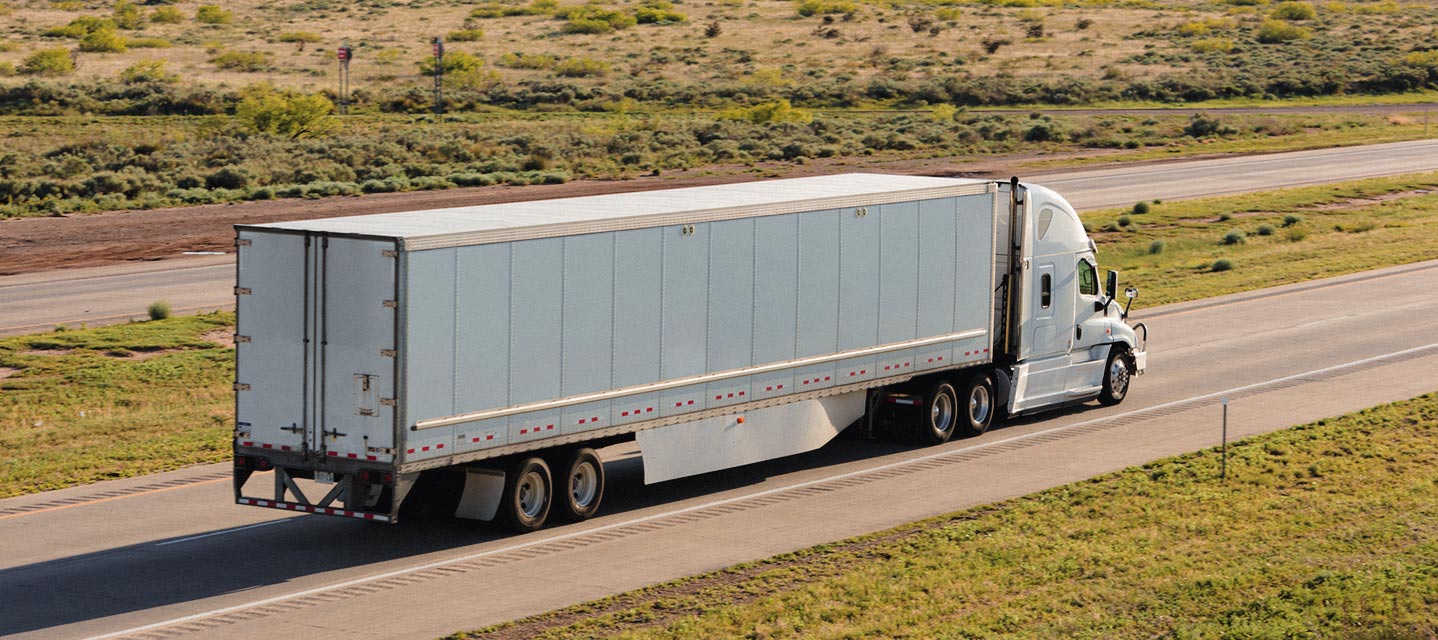
Key Insights
- The future of transportation is driven by electrification, automation, AI and smart infrastructure.
- Innovations like AI fleet management, telematics and autonomous vehicles are transforming logistics.
- Cities like Oslo and Singapore show how data and policy speed up progress.
- Staying ahead helps fleets cut costs, stay compliant and plan for sustainable growth.
From electric vehicles to autonomous trucks and AI-powered routing systems, the future of transportation is already in motion. What started with incremental changes, like better fuel efficiency and connected dashboards, has evolved into full-scale transformation.
Transportation systems are becoming smarter, cleaner and more connected, especially in commercial fleets. As electrification accelerates, data drives real-time decisions and infrastructure adapts, we’re entering a new era of intelligent mobility.
In this post, we break down what’s driving these changes, where innovation is happening and how fleets can prepare. We’ve sourced expert insights from Shweta Shah, AVP, Altitude, Product & Engineering at Geotab, to explore the key transportation trends of the future.
What’s driving the future of transportation?
The future of transportation involves moving into new, smarter sources of energy, modes of transport and the physical and digital infrastructure needed to support them. From electric vehicles to connected roadways, these innovations are reshaping how people and goods move.
According to Shah, the most significant force behind futuristic transportation is the convergence of smart technologies. These smart technologies now work together instead of advancing fleet electrification or autonomy on their own.
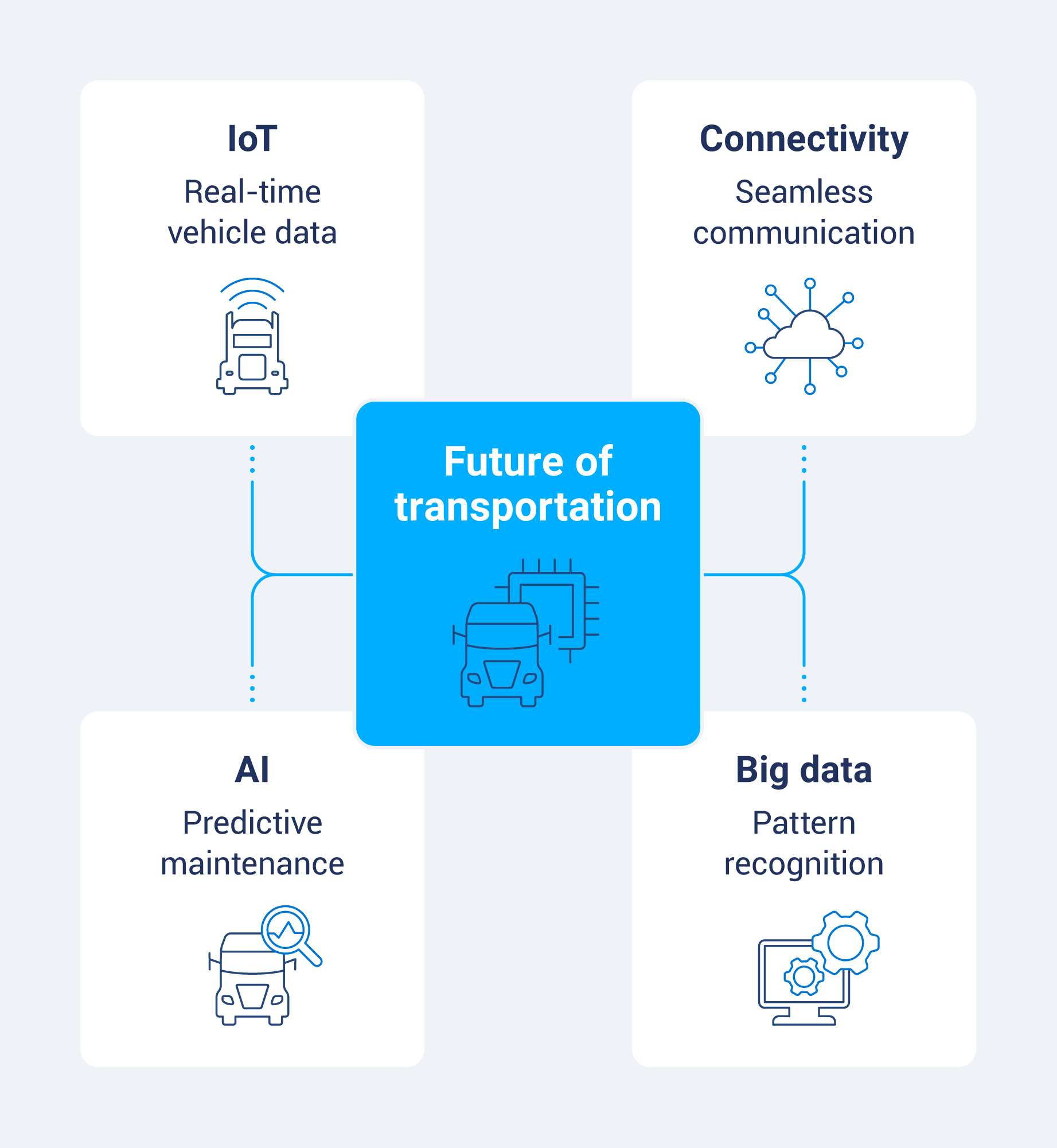
“Instead, it's the powerful synergy of IoT, AI, big data analytics and advanced connectivity, designed to generate actionable insights. This convergence is pivotal for commercial fleets.”
These technologies drive real-time fleet optimization, enable predictive maintenance, and power dynamic routing to move goods more efficiently and sustainably.
These technologies transform transportation from reactive to proactive, enabling self-optimizing systems that improve safety, reduce costs and minimize environmental impact. For commercial fleets, this shift is not just a possibility — it’s already underway.
Expert predictions on futuristic transportation
Transportation is undergoing rapid transformation, and experts agree that the future will be defined by smarter, cleaner and more connected systems. From AI-powered logistics to growing EV charging adoption, three key trends are shaping what comes next.
AI will be the brain behind smart mobility systems
AI is no longer a faraway concept; it’s already at the core of today’s transportation evolution. According to Shah, “AI and automation are poised to reshape both personal and commercial transportation in the near future.”
AI will power adaptive traffic management systems that reduce congestion by dynamically adjusting traffic signals. For consumers, smarter driver assistance features and improved on-demand mobility services will make travel faster and more affordable.
But the biggest shift will likely happen in commercial fleets. Fleets are using AI to fine-tune operations, catch maintenance issues early and automate dispatch in real time.
“Autonomous trucks for long-haul and automated systems for last-mile delivery will reduce operational costs and improve delivery times.”
AI-driven analytics will also help fleets unlock better performance, greater safety and lower emissions.
Electrification will go mainstream, with smart infrastructure to support it
Electrification is rising in the fleet industry. Experts from the IEA predict that the electric vehicle market share will exceed 40% by 2030. For fleets, this shift is happening even faster, especially in last-mile delivery and urban logistics.
The challenge now is scaling the charging infrastructure to match demand. Leading cities like Singapore and Amsterdam are investing in smart grids, charging networks and energy storage systems that help balance grid load and reduce charging costs.
The future of electrification isn’t just about the vehicles; it’s about building the digital and physical infrastructure to power them efficiently.
Regulation will shape the adoption of autonomous and connected vehicles
Technology may power autonomous vehicles (AVs) and connected systems, but regulation will decide how fast they hit the road. Industry leaders are working closely with governments to ensure AVs meet evolving safety standards and data governance policies.
Countries like the U.S., Germany and Singapore are leading efforts to create clear frameworks for self-driving technology. The National Highway Traffic Safety Administration (NHTSA) in the U.S. issued guidelines like the AV 4.0 framework, which outlines federal roles in AV testing and deployment.
Additionally, Germany has legalized Level 4 autonomous driving under specific conditions, making it the first country to set nationwide rules for driverless vehicles. Singapore’s Road Traffic Act includes a regulatory sandbox that allows AV trials on public roads.
These policies will play a major role in how quickly AVs move from pilot projects to mainstream adoption, especially in logistics, where they’re already testing autonomous trucks on long-haul routes.
Examples of transportation technology of the future
Electrification, automation, intelligent infrastructure and bold new mobility concepts are shaping the future of transportation. Many innovations are already being tested, and some are even in limited use today.
From smart platforms that optimize fleet operations in real time to aerial vehicles designed to skip traffic entirely, the next decade will offer a preview of what’s possible.
“Beyond the obvious acceleration of electrification and advanced connectivity, the technology to keep an eye on the next decade will be intelligent, integrated data platforms that provide predictive and prescriptive insights across the entire transportation ecosystem..
These platforms are already powering more dynamic routing, predictive maintenance and driver coaching across commercial fleets — and they’re laying the foundation for AI-powered traffic systems and connected vehicle communication (V2X).”
Below are some other transportation examples that are gaining traction:
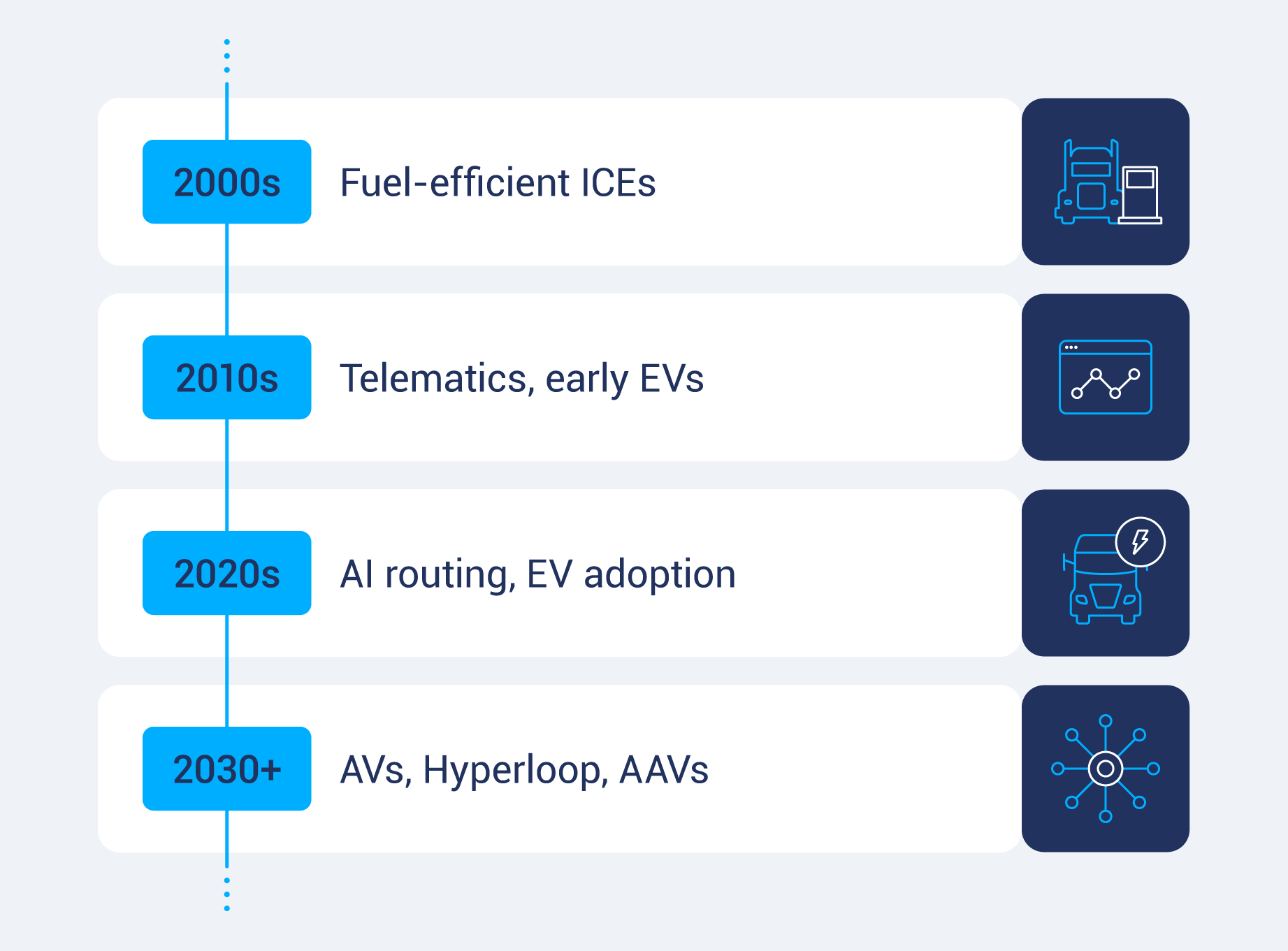
Autonomous aerial vehicles (AAVs)
Will future transportation technology take to the skies? This could soon be a reality. Developers have already completed successful demonstration flights of autonomous aerial vehicles (AAVs). While similar to drones, AAVs carry passengers without a pilot on board.
Most models use vertical take-off and landing (VTOL) through horizontal rotors, allowing them to fly without runways. These vehicles could eventually help commuters bypass road congestion altogether.
Hoverbikes
Like AAVs, hoverbikes use a VTOL platform, but with a human operator onboard. Typically resembling a motorcycle with quadcopter rotors, they are designing these machines for short-distance, off-ground travel.
One such model — the S3 2019 Hoverbike developed by Hoversurf — can reach speeds of 60 mph at an altitude of 33 feet. While not yet practical for mass adoption, hoverbikes hint at how compact air mobility might evolve.
Self-driving cars
Autonomous vehicles already operate in pilot programs, such as Lyft’s autonomous fleet in Las Vegas. These cars represent more than fleet electrification; they’re a critical part of the smart mobility movement.
Using intelligent communication technologies (ICT), self-driving semi-trucks and autonomous cars interact with infrastructure, other vehicles and traffic systems to share data and operate more efficiently. This level of connectivity is key to reducing congestion and improving road safety in future cities.
The Hyperloop
First proposed by Elon Musk in 2012, the Hyperloop is designed for high-speed, long-distance travel between cities. Using magnetic levitation (Maglev) technology and low-pressure tubes, pods could travel at speeds of up to 600 mph, cutting travel times dramatically while minimizing friction and energy use.
Researchers are now exploring Hyperloop projects in India, the United States, the United Kingdom, Canada and Mexico. The proposed Mumbai–Pune corridor in India could become the world’s first full-scale deployment, potentially reducing travel time between the two cities to just 25 minutes, compared to about four hours by standard train.
While the project remains in development, it signals a growing global interest in next-generation rail alternatives.
Industry forecasts also reflect that momentum. The Hyperloop market is expected to grow, projected at a compound annual growth rate (CAGR) of 35.7%, reaching $59.3 billion by 2034.
Delivery drones
Autonomous delivery drones streamline last-mile logistics. These small, crewless aircraft can transport goods directly to homes and businesses, bypassing road traffic and reducing delivery times.
This is especially promising for the food industry. Food transportation facts highlight how rapid delivery and temperature-sensitive handling are crucial for maintaining quality — areas where drone technology offers game-changing potential.
Several companies — including major retailers and logistics firms — are piloting drone delivery services for packages, groceries and medical supplies. For example, Volatus Aerospace, a drone fleet for medical delivery services, is launching soon in Canada.
As regulations evolve, drones could become a regular part of urban delivery networks.
Maglev trains
Magnetic levitation trains offer another fast, frictionless form of future transport. Unlike conventional rail, Maglev trains float above the tracks using magnets, reducing drag and allowing for smoother, quieter and faster travel.
Countries like Japan and China are investing heavily in this technology, with trains capable of reaching speeds up to 407 mph in seven seconds. As urban density increases, Maglev systems could help connect cities faster and more sustainably than current rail networks.
The costs of transportation and motivation for change
The cost of maintaining today’s transportation systems is already high — and rising. These costs extend beyond fuel and vehicle repairs to include infrastructure strain, driver labor, lost time from traffic congestion and long-term environmental damage.
The impact of today’s systems
“The real cost of maintaining today's transportation systems is staggering and multi-faceted,” Shah explains. “It encompasses billions annually in fuel consumption, constant infrastructure repair due to heavy vehicle wear and tear, substantial labor costs for drivers and maintenance and the enormous burden of traffic congestion.”
Fleet experts must also consider the significant environmental impact of greenhouse gas emissions, leading to health issues and climate change. Fortunately, alternative fuels like renewable natural gas (RNG), biodiesel and hydrogen are gaining traction, especially for heavy-duty and long-haul applications.
These financial, environmental and social burdens create a strong case for investment in modern fleet technologies. Electrification and automation can significantly lower fuel use, reduce emissions and extend the lifespan of both vehicles and roads.
And with tools to monitor EV battery health, fleets can maximize uptime and make better decisions about vehicle replacement cycles.
Innovation as a cost-cutting strategy
In the long term, emerging technologies offer a compelling and essential pathway to dramatically reduce these costs. Shah adds, “Electric vehicles inherently have lower ‘fuel’ costs and require less maintenance, leading to significant operational savings and a cleaner environmental footprint.
Autonomous systems, by optimizing routes, can decrease fuel consumption, minimize vehicle wear and decrease infrastructure stress.
While the initial capital investment in these advanced technologies can be higher, the long-term operational savings, enhanced efficiency and substantial environmental benefits far outweigh the upfront costs.”
Fleets that adopt advanced solutions today, such as EVs, AI-powered route planning and battery health analytics, will not only reduce costs but also gain a competitive edge in sustainability, efficiency and performance.
What will happen to today’s transportation?
The transportation of the future won’t make today’s systems obsolete overnight, but transformation is underway. Legacy infrastructure like internal combustion engine (ICE) vehicles, highways and traditional mass transit will continue to serve core functions in the near term.
However, fleets and transit agencies are already shifting to cleaner, smarter models to meet growing demands for efficiency and sustainability.
“By 2040, I believe we’ll see a significant decline in — though likely not complete obsolescence of — personal internal combustion engine vehicle ownership, especially for daily commuting in dense urban centers.”
The confluence of widespread EV adoption, the growth of efficient ridesharing and flexible subscription mobility services will simply make personal ICE vehicle ownership less economically viable and increasingly unnecessary for many.
Transitioning with AI and hybrid models
Rather than immediate replacement, many regions adopt hybrid strategies to modernize transportation systems. Public transit agencies roll out electric buses, integrate on-demand services and use real-time data to optimize service.
Commercial fleets blend electric vehicles for short-range delivery with traditional vehicles for long-haul routes.
AI plays a key role in managing this transition. AI fleet management systems help organizations make smarter decisions about when and where to adopt electric or autonomous vehicles. With tools that support predictive maintenance, route optimization and driver coaching, AI helps fleets modernize without disrupting operations.
As the shift accelerates, legacy infrastructure will need to adapt through data-driven upgrades, flexible fleet planning and smart investment in scalable technologies.
What countries are leading the way in futuristic transportation?
Several countries are setting the pace when it comes to building smarter, more sustainable transportation systems. Norway, the Netherlands and China stand out for their integrated approaches to innovation and long-term planning.
“Cities like Oslo, Amsterdam and Singapore are leading the charge in implementing leading-edge transportation systems.”
Shah says the success stems from a holistic and integrated approach, focusing on several key areas:
- Investment in EV infrastructure: These countries have invested heavily in widespread, accessible charging infrastructure, making EV adoption practical and convenient.
- Supportive policy and incentives: Their governments have implemented robust policies, including tax breaks and subsidies, to actively incentivize EV adoption for both consumers and commercial fleets.
- Data-driven urban planning and management: They’re leveraging data and IoT fleet management extensively for real-time traffic management, dynamic public transport optimization and smart city initiatives that integrate various transportation modes.
“These global leaders show how the future of transportation relies on both technology and policy. Their investments are creating more connected, efficient and low-emission systems that other regions can learn from.”
How to prepare for the transportation of the future
Fleets that want to stay competitive must act now. Electrification, AI integration and data-driven operations will shape the future of transportation. For logistics companies, commercial fleets and tech startups, preparation means investing in the right tools, infrastructure and workforce.
Focus on data and telematics
“Fleets must take proactive and strategic steps today to prepare for the significant shifts ahead,” says Shah. “Their future competitiveness and viability depend on it.”
Make data a core part of your operations by:
- Using fleet telematics to monitor vehicle performance and driver behavior
- Optimizing routes to reduce fuel use and emissions
- Enabling predictive maintenance to reduce downtime
- Using fleet data to evaluate the cost and feasibility of EV transitions
Start your electric vehicle (EV) transition
As EV adoption gains speed, successful transitions require planning. Shah recommends starting small with pilot programs for last-mile delivery or short, repeatable routes. Be prepared to:
- Evaluate charging needs and station availability
- Manage range and vehicle suitability by route
- Understand the long-term cost of ownership and maintenance
Explore pilot automation and ADAS technologies
Automation is already available in the form of advanced driver assistance systems (ADAS). As autonomous vehicle technology matures, Shah suggests that fleets should:
- Invest in vehicles with safety and automation features
- Identify routes best suited for partial or full autonomy
- Begin testing AI-powered systems for dispatch, routing and fleet maintenance planning
Prepare your team for change
Technology is only part of the shift. Workforce readiness is key. Begin driver training programs to:
- Upskill drivers and technicians on EV systems and telematics
- Prepare staff to work with AI tools and automation systems
- Encourage a culture of safety, data awareness and adaptability
“By proactively focusing on these interconnected areas, fleets can not only adapt to the rapidly evolving transportation landscape but also secure a significant competitive advantage.”
The road ahead: What’s next for transportation
As technology continues to evolve, the transportation industry will see even more integration between data, automation and infrastructure. Fleets that embrace AI tools, invest in EV readiness and adapt to policy shifts will be better positioned to scale efficiently and sustainably.
To take the next step toward preparing for the future of transportation, explore how Geotab’s fleet optimization software can help your business make smarter, data-driven decisions.

Subscribe to get industry tips and insights
Frequently Asked Questions
By 2025, transportation will connect, drive data and electrify more. Fleets and cities will increasingly rely on real-time insights to improve safety, reduce emissions and optimize operations.
Future transportation technology design will focus on sustainability, automation and efficiency. Expect more electric vehicles, smarter infrastructure and modular systems that adapt to changing mobility needs.
Flying cars are developing, but widespread use is still years away. The technology advances, but regulatory, safety and infrastructure challenges remain.
The Geotab Team write about company news.
Table of Contents
- What’s driving the future of transportation?
- Expert predictions on futuristic transportation
- Examples of transportation technology of the future
- The costs of transportation and motivation for change
- What will happen to today’s transportation?
- What countries are leading the way in futuristic transportation?
- How to prepare for the transportation of the future
- The road ahead: What’s next for transportation
Subscribe to get industry tips and insights
Related posts

Collision avoidance systems: How fleets prevent incidents and improve safety
December 23, 2025
5 minute read

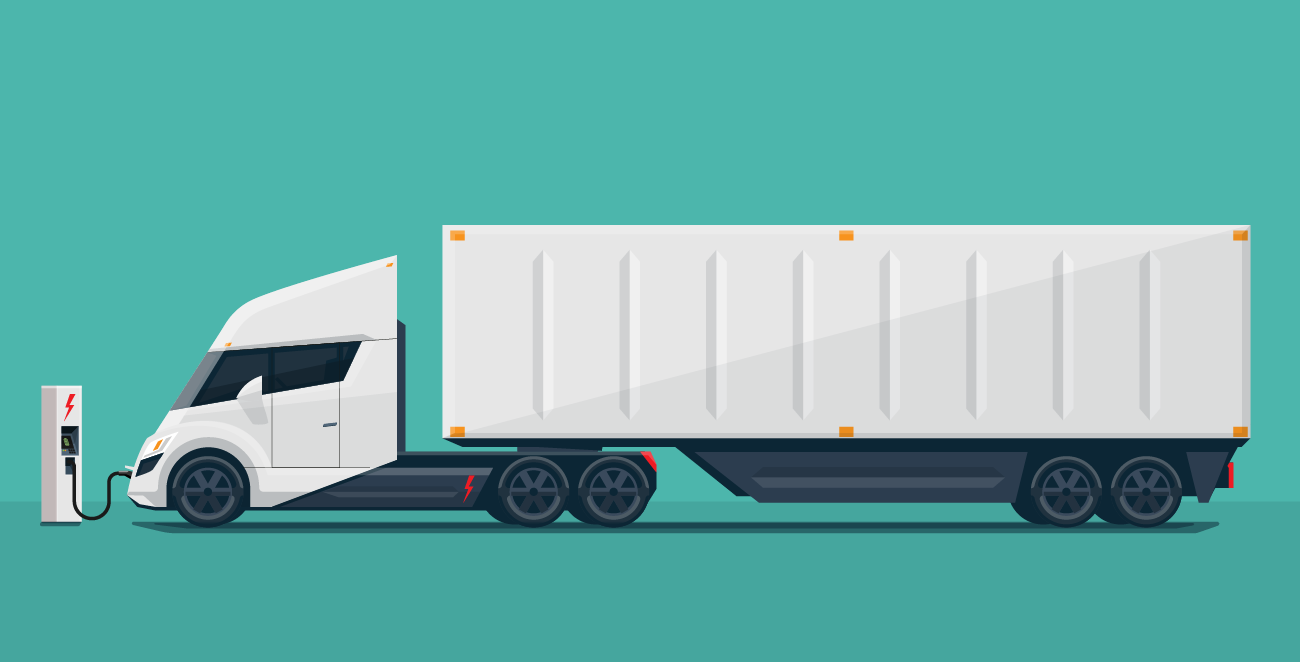
Autonomous trucking: The impact of self-driving trucks in the freight industry + guide
July 30, 2025
6 minute read
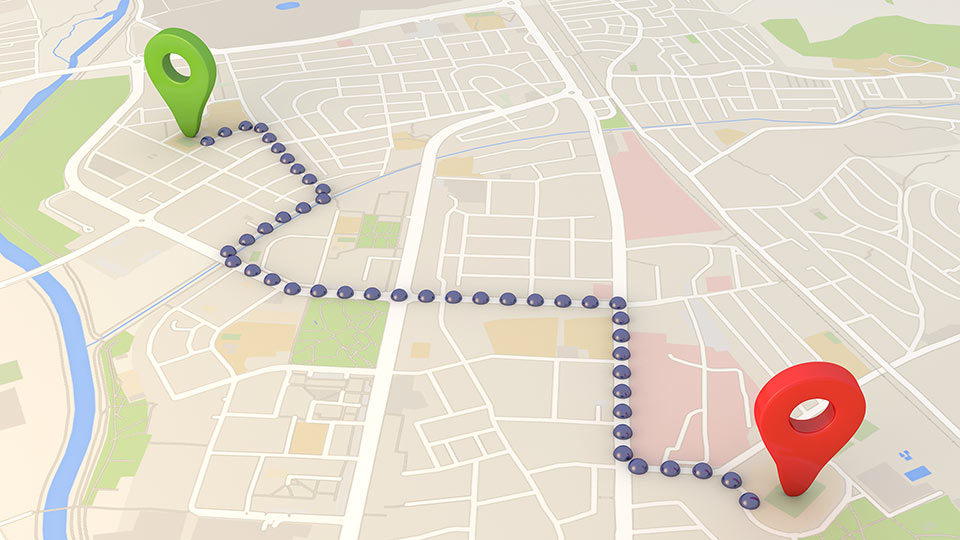
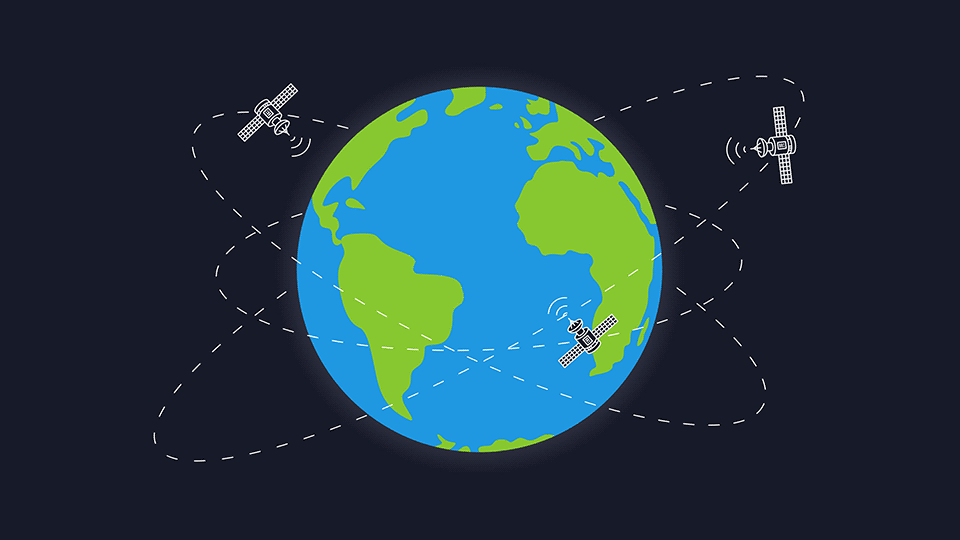

Smart selection guide for school bus fleet maintenance features
May 21, 2025
5 minute read